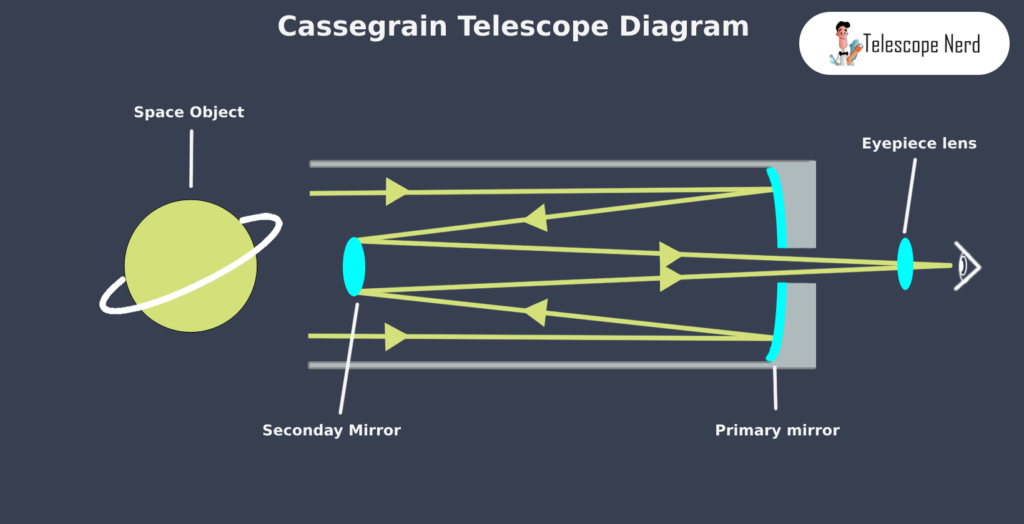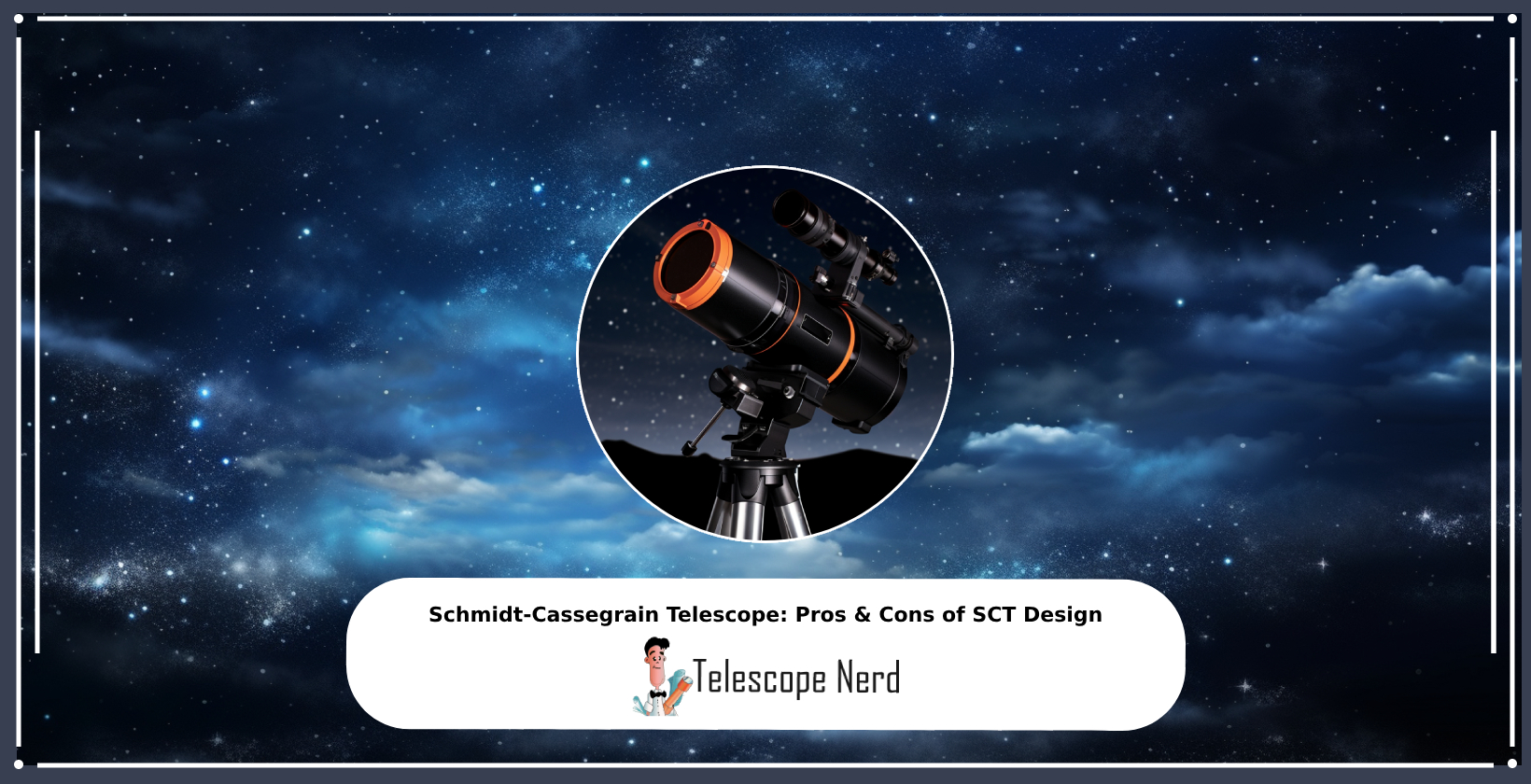Cassegrain Telescope: Classical Design, Advantages, Comparison
The Cassegrain reflector is a type of telescope that uses a combination of a concave primary mirror and a convex secondary mirror to gather and refocus light, producing magnified images of distant celestial objects. Knowing the interplay between these mirrors is vital to optimizing observations with the Cassegrain design.
The Cassegrain telescope’s ability to provide high magnification in a relatively short optical tube has established itself as a common choice for both observatories and personal users alike. The Cassegrain reflector is designed to optimize light collection and enhance image clarity, making it particularly effective for observing deep-space phenomena.
The Cassegrain is a reflector that works using a primary concave mirror and a secondary convex mirror. The Cassegrain reflector’s advantages include its compact design and versatility, but it also has disadvantages. The disadvantages are able to be minimized by selecting the best Cassegrain model.
How Does a Cassegrain Telescope Work?
The Cassegrain reflector works using a primary concave mirror to collect and redirect incoming light toward the secondary mirror, and a secondary convex mirror to further concentrate that light and direct it to the eyepiece.
The light-gathering process begins when light enters the telescope through its aperture. This light encounters the primary parabolic mirror at the back of the telescope. The primary mirror’s role is to collect and redirect the light, aiming it toward the secondary hyperbolic mirror. The secondary mirror’s purpose is to further concentrate the incoming light and redirect it through a hole in the primary mirror, guiding it to an eyepiece or another optical instrument.
The combination of the primary and secondary mirrors ensures the light’s pathway is folded within the telescope, which allows for a longer focal length in a shorter optical tube. The long focal length and short optical tube make the Cassegrain both portable and powerful. The primary mirror’s concave shape ensures the light is focused, while the secondary mirror’s convex shape further magnifies and directs this light to the eyepiece.

Cassegrain telescope equations allow telescope users to calculate and understand the behavior of light as it reflects off the mirrors. By knowing the relationship between the focal lengths and the radii of curvature, observers optimize the telescope’s design for specific tasks or observational priorities.
The primary mirror is parabolic, meaning it’s designed to bring parallel rays of light to a single focal point without the distortion of spherical aberration. To calculate the focal length of the primary mirror, divide the radius of curvature by 2.
The secondary mirror is hyperbolic, meaning it’s crafted to minimize off-axis aberrations while refocusing the light and magnifying the image. To determine the magnification factor, divide the distance between the system focal plane and the secondary by the distance between the secondary to the focal point of the primary.
While the Cassegrain design is commonly used for its efficiency and compactness, other telescope types are beneficial for unique observational goals.
How does a Cassegrain Telescope Compare to a Dobsonian?
The Dobsonian telescope is a type of altazimuth-mounted Newtonian reflector. The design focuses on simplicity, providing a large and cost-effective aperture in a stable and easily maneuverable mount. This makes the Dobsonian particularly suitable for beginners and those interested in deep-sky observations.
The Cassegrain employs a primary concave mirror and a secondary convex mirror. In contrast, the Dobsonian utilizes a parabolic primary mirror that captures and directs light to a flat secondary mirror, which then reflects it to the eyepiece. The Dobsonian’s specialty lies in its user-friendly design, combined with its powerful light-collecting capability, which is often housed in a mount that’s easy to move and adjust.
When comparing the Dobsonian vs Cassegrain, it’s evident that while both are reflectors, they cater to different observational preferences. The Cassegrain’s compact structure and its ability to provide high magnification make it a favored choice for planetary and lunar observations, as well as for astrophotography. The Dobsonian, with its larger aperture, is known for deep-sky viewing, capturing faint nebulae, galaxies, and star clusters.
One of the prominent advantages of the Dobsonian is its cost-effectiveness for the size of the aperture. Its simplistic design also makes it relatively easier for beginners to set up and use. However, its bulkiness is a disadvantage for those looking for portability. While the Cassegrain telescope’s compactness is an advantage for transport and storage, it is generally more complex to collimate and comes at a higher price point for the same aperture size compared to a Dobsonian. For example, a 10-inch Cassegrain generally costs between $1,000 and $2,000 (€921.35 and 1,842.70), while an equivalent Dobsonian generally costs $500 to $1,000 (€460.95 to €921.35). The choice between types often boils down to the specific observational needs, budget, and preferences of the astronomer.
What Are the Advantages of Cassegrain Telescopes?
The Cassegrain telescope, with its specific configuration of mirrors, presents a set of distinct advantages in performance, including the 5 following features.
- Compact Design
- High Magnification Abilities
- Versatility in Observations
- Suitable for Astrophotography
- Adaptable to Sophisticated Mounts
The Cassegrain’s unique and compact optical design allows it to have a long focal length in a short optical tube. This results in a telescope that’s easier to transport and store. The short tube length, paired with the folding of the optical path within the system, provides a compact form without compromising on image quality.
The Cassegrain is designed with a concave primary mirror and a convex secondary mirror. This configuration concentrates light effectively, granting the telescope the ability to provide higher magnifications, which is particularly useful for detailed planetary and lunar observations.
Thanks to its design, the Cassegrain telescope is not just limited to one type of observation. Whether it’s planetary, lunar, or deep-sky objects, the Cassegrain is able to handle a variety of observational challenges, making it a favorite among many astronomers.
The Cassegrain’s ability to provide high magnification and its adaptability to various mounts, especially equatorial ones with tracking capabilities, make it suitable for astrophotography. Its stable optics support long-exposure shots, capturing details of distant celestial objects.
Many Cassegrain telescopes are designed to be compatible with motorized tracking mounts. This adaptability allows the telescope to follow celestial objects as they move across the sky, a feature essential for both detailed observations and astrophotography.
What are the Disadvantages of Cassegrain Telescopes?
The Cassegrain’s unique optical setup and structure also give rise to particular drawbacks, which affect observational quality and user experience in specific scenarios. The three most notable disadvantages of Cassegrain telescope are as follows.
- More Complex Collimation
- Higher Cost of Aperture
- Potential for Central Obstruction
The Cassegrain’s design requires precise alignment of its optical elements. Collimating a Cassegrain is generally more challenging than simpler telescope designs, like the Newtonian. Proper collimation is essential to ensure optimal image quality, but the complexity deters beginners or those unfamiliar with the process.
When comparing telescopes of the same aperture size, a Cassegrain often comes at a higher price point than, for instance, a Dobsonian. This cost difference is attributed to the more intricate optical design and construction of the Cassegrain.
Due to the placement of the secondary mirror, Cassegrain telescopes have a central obstruction, which reduces contrast in some observations. However, it’s essential to note that many observers find this obstruction negligible in practical use.
In choosing the best Cassegrain model, it’s imperative to weigh these advantages and disadvantages according to one’s observational needs and preferences. Different models will offer specialized features to provide the optimal observational experience.
What are the Best Cassegrain Telescopes?
The best Cassegrain telescopes are evaluated based on specific criteria, including their suitability for varied uses, performance metrics, construction quality, and their standing within the astronomy community.
A novice astronomer will prioritize user-friendliness and simplicity, while advanced users often look for advanced features and adaptability for specialized tasks such as astrophotography. Thus, the best Cassegrain for observational astronomy focuses on achieving a harmonious balance between magnification power, aperture, and user-friendly design.
Performance pertains to the telescope’s ability to deliver sharp, clear images with minimal optical distortions. This clarity is indicative of superior optics, meticulously crafted mirrors, and the precise alignment of the instrument’s components. A Cassegrain’s prowess is often be judged by its capability to discern intricate details on celestial bodies, especially the intricate facets of planets and the moon’s surface.
The longevity and resilience of a Cassegrain also determine its quality. This encompasses the sturdiness of the tube, the reliability of the mount, and the durability of other associated components. A top-tier Cassegrain should be robust enough to endure regular usage, resist environmental wear and tear, and maintain its internal alignment over prolonged periods.
Popularity often serves as an indicator of a telescope’s effectiveness and reliability. In the realm of Cassegrain telescopes, brands like Celestron and Meade have forged a reputation by consistently designing high-quality telescopes. These models have consistently demonstrated their worth, making them trusted staples in the astronomical community.

